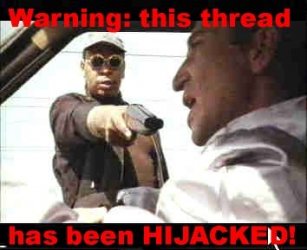B
Black Bear
Guest
How people cope with their blind spots, aka talking to idiots aka the worst of self-defense
Does this conversation sound familiar?
SCSDI = so-called self-defense instructor
BI = beautiful ingénue, played by Natalie Portman
SCSDI Now, the techniques I will be teaching you are for if you have no opportunity to escape. The best thing to do is always to always to try to get away. But there may be situations where you are not able to just leave. For instance, if you are attacked while loading groceries into your trunk, and your child is in the backseat. Or youre with your frail or handicapped friend or relative. Or when youre waiting for someone outside a public restroom and dont want to leave them behind. Or youre in an enclosed area and your escape routes are blocked off. Then you must fight in order to create an escape.
BI Got it.
SCSDI Now, its important to remember: if someone comes at you with a knife, then run away.
BI But what if you dont have a chance to run?
SCSDI Then use the techniques I will show you today.
BI Are you going to show us what to do if someone attacks us with a knife?
SCSDI Like I said, if someone attacks you with a knife, then you should run.
BI What if you cant run?
SCSDI If you cannot escape from an attacker, you must defend yourself with resolute determination! Thats what were here for, I shall teach you how!
BI And if he has a knife?
SCSDI I dont follow. Didnt we just go over that?
BI *frustrated* Okay, what I mean is, what if someone attacks you with a knife, and theres no way for me to just get away?
SCSDI Whats in your wallet thats worth your life?
BI I never said he wanted my wallet. I said hes attacking me with a knife and I cant
SCSDI Are you trying to make me look bad?
BI - *throws up hands in frustration* Forget it! Keep my deposit, Im going to Black Bears International House of Pancrase! Besides, Black Bear is stunningly attractiveand a fantastic lay too! Come on, Alizee Bilder and Haylie Ecker! I heard he might be into threesomes!
Does this conversation sound familiar?
SCSDI = so-called self-defense instructor
BI = beautiful ingénue, played by Natalie Portman
SCSDI Now, the techniques I will be teaching you are for if you have no opportunity to escape. The best thing to do is always to always to try to get away. But there may be situations where you are not able to just leave. For instance, if you are attacked while loading groceries into your trunk, and your child is in the backseat. Or youre with your frail or handicapped friend or relative. Or when youre waiting for someone outside a public restroom and dont want to leave them behind. Or youre in an enclosed area and your escape routes are blocked off. Then you must fight in order to create an escape.
BI Got it.
SCSDI Now, its important to remember: if someone comes at you with a knife, then run away.
BI But what if you dont have a chance to run?
SCSDI Then use the techniques I will show you today.
BI Are you going to show us what to do if someone attacks us with a knife?
SCSDI Like I said, if someone attacks you with a knife, then you should run.
BI What if you cant run?
SCSDI If you cannot escape from an attacker, you must defend yourself with resolute determination! Thats what were here for, I shall teach you how!
BI And if he has a knife?
SCSDI I dont follow. Didnt we just go over that?
BI *frustrated* Okay, what I mean is, what if someone attacks you with a knife, and theres no way for me to just get away?
SCSDI Whats in your wallet thats worth your life?
BI I never said he wanted my wallet. I said hes attacking me with a knife and I cant
SCSDI Are you trying to make me look bad?
BI - *throws up hands in frustration* Forget it! Keep my deposit, Im going to Black Bears International House of Pancrase! Besides, Black Bear is stunningly attractiveand a fantastic lay too! Come on, Alizee Bilder and Haylie Ecker! I heard he might be into threesomes!


